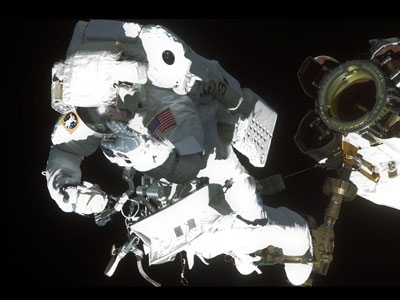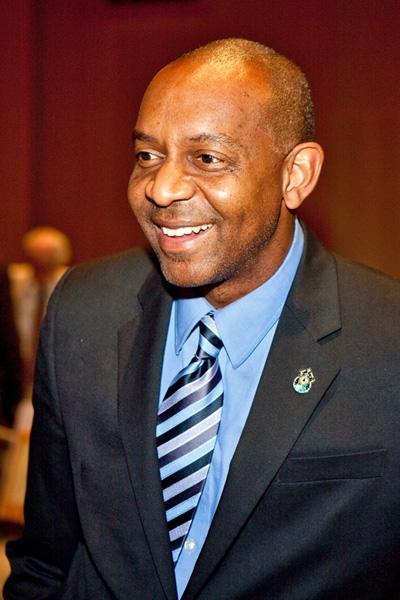As an orthopedic oncologist who studies bone that has been damaged by cancer, Robert “Bobby” Satcher ’86, PhD ’93, HST MD ’94 is also interested in the effects of microgravity on the human body. He got the chance to experience those effects firsthand when he became the first orthopedic surgeon to venture into space in November 2009.
Satcher was one of six astronauts who spent 11 days aboard the recently retired shuttle Atlantis as part of NASA’s STS-129 Space Shuttle mission to deliver 14 tons of spare parts to the International Space Station (ISS). During the mission, he completed two spacewalks to attach hardware to the exterior of the ISS that will help keep the research facility running until 2015.
“It’s definitely the most physically demanding thing we do as astronauts,” Satcher, speaking at a talk at MIT on Tuesday hosted by the Harvard-MIT Division of Health Sciences and Technology (HST), said about his spacewalk experience. “It’s really kind of a sensory overload.”
If anyone could handle the physical and mental stress of that task, it would be Satcher, according to Joseph R. Madsen, an associate professor of neurosurgery at Harvard Medical School and president of the HST Alumni Association. “Dr. Satcher demonstrates the core idea of the HST program — combining a deep understanding of human biology with a deep understanding of engineering and science to accomplish things that can hardly be imagined,” he said.
Space surgery
Satcher has been on leave as an assistant professor of orthopedic surgery at the Northwestern University Feinberg School of Medicine since 2004, when he was selected to be an astronaut. Prior to the launch of STS-129, Satcher underwent 18 months of rigorous mission training that included land- and water-survival classes and learning about the technical aspects of the space shuttle and orbital mechanics.
Despite that intensive astronaut training, it was actually Satcher’s medical background that proved to be the most valuable during the mission. Satcher said that his surgical experience helped prepare him for using highly sophisticated instruments during the two spacewalks he completed that totaled more than 12 hours. During the first spacewalk, he helped attach a spare antenna to the ISS and perform maintenance work on a robotic arm, and during his second spacewalk, he helped install a new high-pressure oxygen tank.
Satcher, who holds a doctorate in chemical engineering from MIT, said he was most intrigued with the scientific aspects of the mission, including conducting short-term experiments and delivering equipment for ongoing experiments on the ISS.
He was particularly interested in the orthopedic experiments, such as measuring how the astronauts’ heights increased in space as a result of the absence of gravity, or microgravity, and delivering mice that over-express a gene related to osteogenesis, or the process of bone formation, to the ISS. The mice will be brought back during a later mission to see how their skeletons develop in space and whether they experience bone loss.
As an orthopedic surgeon, Satcher is also interested in the negative side effects of microgravity. Although scientists have known for decades that microgravity causes bone to lose essential minerals, muscles to atrophy and the cardiovascular system to weaken, they are still experimenting with different countermeasures to pinpoint the best way to keep astronauts healthy.
Satcher was eager to test various resistive exercises, including doing squats or running attached to a treadmill, that he believes are “very effective” countermeasures to offset the effects of microgravity. “We know exercise works,” he said, adding that it still took several days for his muscles and sense of balance to readjust when he returned to Earth.
Because the space shuttle program is scheduled to end later this year, Satcher said that he would have to fly aboard a Russian spacecraft if he wanted to return to space before 2020. Even so, he remained positive about NASA’s future under President Obama’s new space policy, which would boost NASA’s budget by $6 billion over the next five years. “NASA has done a tremendous amount with very little,” he said, adding that American taxpayers pay more each year for Halloween activities ($25) than they do to send people into space ($20).
Satcher was one of six astronauts who spent 11 days aboard the recently retired shuttle Atlantis as part of NASA’s STS-129 Space Shuttle mission to deliver 14 tons of spare parts to the International Space Station (ISS). During the mission, he completed two spacewalks to attach hardware to the exterior of the ISS that will help keep the research facility running until 2015.
“It’s definitely the most physically demanding thing we do as astronauts,” Satcher, speaking at a talk at MIT on Tuesday hosted by the Harvard-MIT Division of Health Sciences and Technology (HST), said about his spacewalk experience. “It’s really kind of a sensory overload.”
If anyone could handle the physical and mental stress of that task, it would be Satcher, according to Joseph R. Madsen, an associate professor of neurosurgery at Harvard Medical School and president of the HST Alumni Association. “Dr. Satcher demonstrates the core idea of the HST program — combining a deep understanding of human biology with a deep understanding of engineering and science to accomplish things that can hardly be imagined,” he said.
Space surgery
Satcher has been on leave as an assistant professor of orthopedic surgery at the Northwestern University Feinberg School of Medicine since 2004, when he was selected to be an astronaut. Prior to the launch of STS-129, Satcher underwent 18 months of rigorous mission training that included land- and water-survival classes and learning about the technical aspects of the space shuttle and orbital mechanics.
Despite that intensive astronaut training, it was actually Satcher’s medical background that proved to be the most valuable during the mission. Satcher said that his surgical experience helped prepare him for using highly sophisticated instruments during the two spacewalks he completed that totaled more than 12 hours. During the first spacewalk, he helped attach a spare antenna to the ISS and perform maintenance work on a robotic arm, and during his second spacewalk, he helped install a new high-pressure oxygen tank.
Satcher, who holds a doctorate in chemical engineering from MIT, said he was most intrigued with the scientific aspects of the mission, including conducting short-term experiments and delivering equipment for ongoing experiments on the ISS.
He was particularly interested in the orthopedic experiments, such as measuring how the astronauts’ heights increased in space as a result of the absence of gravity, or microgravity, and delivering mice that over-express a gene related to osteogenesis, or the process of bone formation, to the ISS. The mice will be brought back during a later mission to see how their skeletons develop in space and whether they experience bone loss.
As an orthopedic surgeon, Satcher is also interested in the negative side effects of microgravity. Although scientists have known for decades that microgravity causes bone to lose essential minerals, muscles to atrophy and the cardiovascular system to weaken, they are still experimenting with different countermeasures to pinpoint the best way to keep astronauts healthy.
Satcher was eager to test various resistive exercises, including doing squats or running attached to a treadmill, that he believes are “very effective” countermeasures to offset the effects of microgravity. “We know exercise works,” he said, adding that it still took several days for his muscles and sense of balance to readjust when he returned to Earth.
Because the space shuttle program is scheduled to end later this year, Satcher said that he would have to fly aboard a Russian spacecraft if he wanted to return to space before 2020. Even so, he remained positive about NASA’s future under President Obama’s new space policy, which would boost NASA’s budget by $6 billion over the next five years. “NASA has done a tremendous amount with very little,” he said, adding that American taxpayers pay more each year for Halloween activities ($25) than they do to send people into space ($20).







